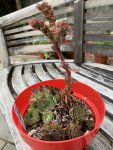Don't see why it wouldn't be as the label said. The stem with the growths was a flower stalk, Sempervivum are monocarpic, meaning they flower and then the rosette that flowered dies, you generally get small rosettes forming around the one that has died. You are often with a hole in the clump for a year or two.
There are a lot of Sempervivum varieties many of which look very similar. They have been grown in England for centuries often on a roof, they were supposed to keep lightening away and they have a number of common names such as "Houseleek" see here for more
https://en.wikipedia.org/wiki/Sempervivum_tectorum
They are originally Alpine plants that have evolved to cope with dry conditions, high UV levels and being covered with snow. They are often found growing in cracks in rocks and sometimes no soil can be seen.
In cultivation they need a gritty well drained soil base compost (50% John Innes 2:50% grit for example). If growing in a pot make sure there are plenty of holes in the base of the pot. They are often grown in shallow clay pots and I would avoid plastic pots. They are popular plants for growing in sinks and other such containers. I grow several varieties on a rockery, others are on/in dry stone walls. I have grown them on a brick in the frog with a couple of drainage holes drilled through and some gritty soil round the roots. These have suffered the attentions of Blackbirds rooting around for insects and throwing the rosettes out. For planting in rockery crevices and dry stone walls I remove most of the compost it came in, especially if peat based, feed the roots into the crevice, gap in wall, then fill this with gritty soil and water in repeat until the crevice/gap is full. Generally they don't need water or feed.




 ......the rosettes will die after they have flowered, that`s normal, but then new ones will appear on runners. These are very easy to propagate.
......the rosettes will die after they have flowered, that`s normal, but then new ones will appear on runners. These are very easy to propagate.